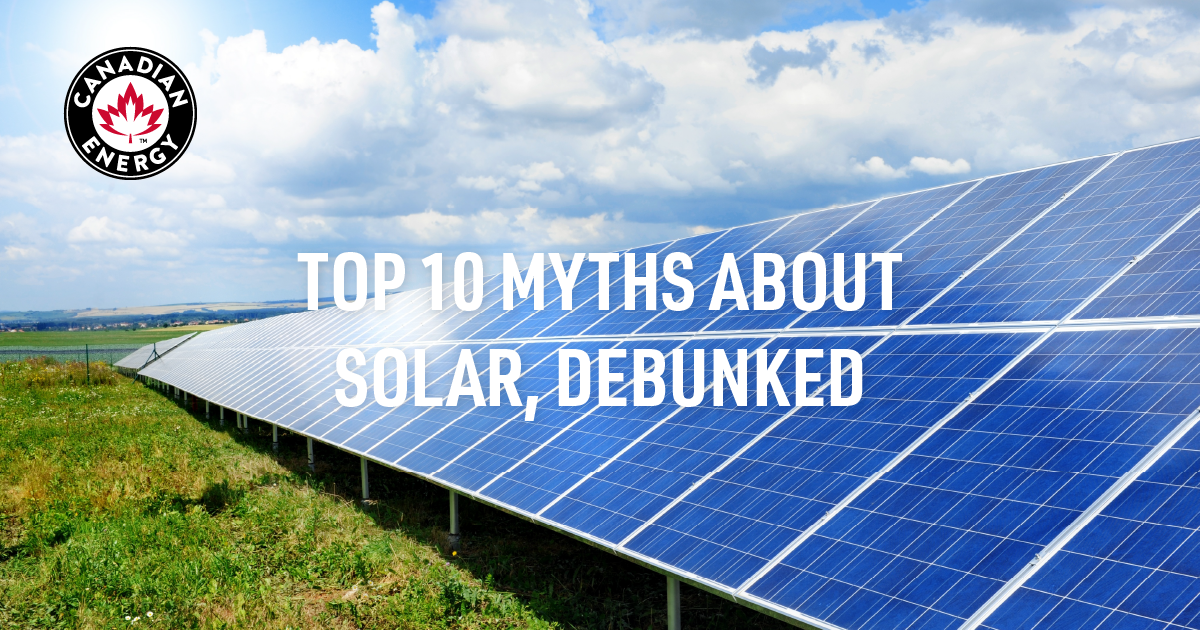Top 10 Myths About Solar Debunked!

Myth 1: Solar panels don’t work in cold climates
Most solar panels actually work best in cold conditions, as long as it’s sunny. Cold temperatures increase their conductivity, letting electricity flow more efficiently. Higher temperatures, on the other hand, reduce the panels’ efficiency. As solar panels heat up, they generate less electricity from the same amount of light.
Myth 2: Solar panels are eyesores
Due to the growing popularity of solar power, there are many different options, even solar panel roofing shingles. As going green has become popular, people are beginning to see solar panels as a great thing, so drawing attention to your own solar generating equipment may be the in thing.
Myth 3: Solar panels require a tracking system to follow the angle of the sun.
If solar panels are properly installed, they are positioned to get the most exposure to the sun, so tracking systems are not required. Some newer panels do use tracking subsystems to adjust the panel’s position throughout the day, but the additional expense may not be worth the limited efficiency gains.
Myth 4: Solar panel systems store excess energy in batteries.
The vast majority of home solar power systems don’t store energy in batteries. They’re connected to the power grid via net metering, and homeowners are credited with the energy their solar panels add to the electrical grid. Though it is possible to add a battery to your solar installation, doing so increases the cost of materials, installation, and maintenance.
Myth 5: Solar panels will cause more harm to the environment when they’re thrown away in 25 years.
Actually, most panel manufacturers will recycle the panels after you’re through in 25 years. It’s hard to say whether people will actually need to recycle them because most panels are still being used today. So it’s up to you find out about the manufacturer’s panel recycling program.
Myth 6: The utility grid can’t handle my solar panels.
First of all, residential solar systems carry relatively little energy, so it’s not going to affect most existing wires unless they already needed repairs. What is true and has been in the news lately is that these large solar and wind farms need some serious infrastructure to carry their green energy from the rural open spaces where they’re being built to the grid. Also, the North American grid remains one of the most reliable electric systems in the world. Overall, the grid is working fine 99% of the time. That’s why for most urban and suburban people, battery back up systems aren’t that cost effective. That being said, the grid is behind in terms of being “smart,” so we do need new technology to more efficiently allocate all of our energy, whether solar or coal.
Myth 7: Solar panels have a high carbon footprint and are not sustainable
Solar panels are usually made from silicon. Silicon is found in sand, one of the most widespread natural elements on earth. The ovens used to transform the sand into silicon use a lot of energy - that is true. But the payback time for the energy used to produce a solar panel is only one to two years. This means that in this time the panel generates the total amount of energy that has been used in its entire production. All power generated after the payback time is pure green profit, while solar panels can last 25 to 40 years! Other sources of energy have much longer payback times. Specifically, nuclear power plants have extremely long payback times - so long in fact that it is questionable whether all the power that generated during their lifetime is enough to pay for the energy used to build and disassemble them.
Myth 8: Solar panels are only attractive in niche markets
Solar energy is an attractive product in any place in which people need electricity - which nowadays is anywhere in the civilised world, globally. That is a much larger market than just large-scale solar plants in desert areas, which are very competitive markets because they require the creation of new grids, are competing with wholesale electricity prices and are crowded with many other power-generating enterprises. When you focus on solar panels that can be mounted on a rooftop, for household or entrepreneurial use, you can compete against the local consumer and corporate rates for electricity. You can compare this with the market for compact fluorescent lamps, where the consumer saves money on a longer term by investing a small sum of money. The ROI is made at the end-consumer level: the cost of the electricity bill. The investments are very simple, and no new grids or other types of costly infrastructure are needed.
Myth 9: Solar will lower the value of your home
Quite the contrary – buying a solar energy system will likely increase your home’s value. A recent study found that solar panels are viewed as upgrades, just like a renovated kitchen or a finished basement, and home buyers across the country have been willing to pay a premium of about $15,000 for a home with an average-sized solar array. As for third-party owned systems, it appears that the impact is largely neutral but can occasionally add value, especially for prepaid leases. SunShot in the USA is currently funding a project to learn more about third-party owned systems and their effects on home valuation.
Myth 10: Solar power will get more efficient, so I should wait to buy or install.
While many companies are working to improve the efficiency of solar panels, the current technology for solar panels is well established — in fact, we’ve been using the same solar technology, more or less, since the 1960s. The potential efficiency gains of future panels are small compared to the panels ready for installation today, and the efficiency gains when measured in total dollars saved on your energy bills is miniscule.
